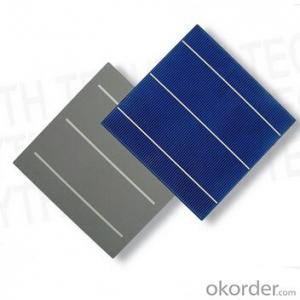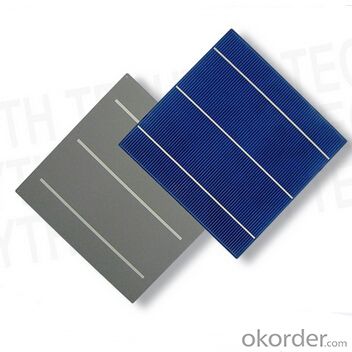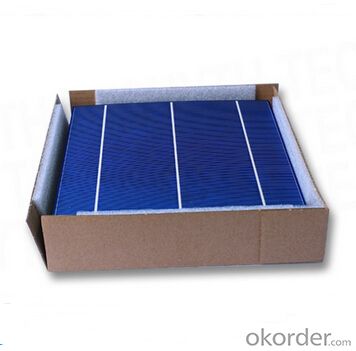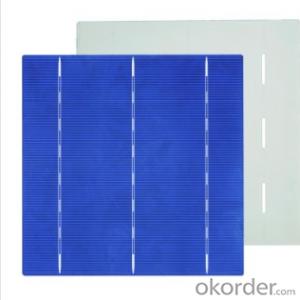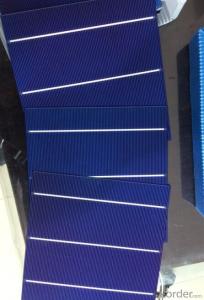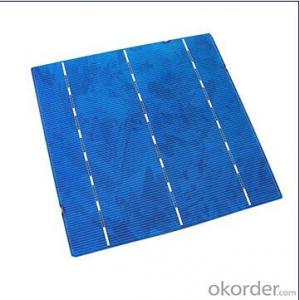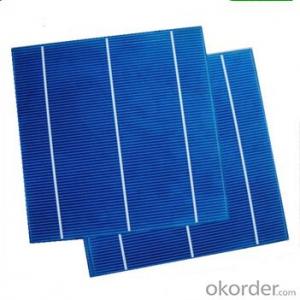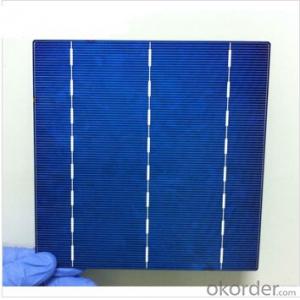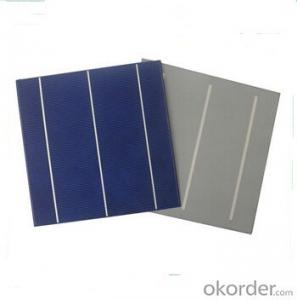Indoor Polycrystalline Solar Cells Series - C-16.80%
- Loading Port:
- Shanghai
- Payment Terms:
- TT OR LC
- Min Order Qty:
- 3000 pc
- Supply Capability:
- 300000 pc/month
OKorder Service Pledge
OKorder Financial Service
You Might Also Like
Solar Cells:
Solar cells is made by solar wafer, it has three categories of solar cell right now, monocrystalline polycrystalline and thin film,These cells are entirely based around the concept PN junction, which is the critical part of solar module, it is the part that can convert the light energy into electricity, the thickness is from 180um to 200um, with even busbars to conduct electricity, textured cell can decrease diffuse reflection; they are often electrically connected and encapsulated as a module. Photovoltaic modules often have a sheet of glass on the front (sun up) side, allowing light to pass while protecting semiconductor wafers from abrasion and impact due to wind-driven debris, rain, hail, etc. Solar cells are also usually connected in series in modules, creating an additive voltage. Connecting cells in parallel will yield a higher current;With high quality and stable quality. Our Cells can greatly improve the performance of Solar Modules.
Features:
1. High conversion efficiencies resulting in superior power output performance.
2. Outstanding power output even in low light or high temperature conditions
3. Optimized design for ease of soldering and lamination
4. Long-term stability, reliability and performance
5. Low breakage rate
Solar Cells Advantage:
• High efficiency and stable performance in photovoltaic conversion.
• Advanced diffusion technique ensuring the homogeneity of energy conversion efficiency of the cell.
• Advanced PECVD film forming, providing a dark blue silicon nitride anti-reflection film of homogenous color and attractive appearance.
• High quality metal paste for back surface and electrode, ensuring good conductivity, high pulling strength and ease of soldering.
• High precision patterning using screen printing, ensuring accurate busbar location for ease with automatic soldering a laser cutting.
Specifications:
Kit content:
Product: multicrystalline cell based on poly silicone
Format: 156 x 156mm ± 0.5mm
Front contacts (-): 3*1.5mm wide bus bars (silver), acid texturized surface, blue silicone nitride antireflection coating
Back contacts (+): 3*3mm wide bus bars (silver/aluminum), aluminum backside metallization
Warranty:
Repairs: For repairs please contact to us
Exchange service: You can choose between a refund, exchange or credit where goods are faulty or doesn’t do what it’s supposed to do
| Model | C16.80% |
| Max power | 2W |
| Short-circuit current (Isc) | 4.205A |
| Imax at 0.5V | 4A |
| Open circuit voltage (Voc) | 0.62V |
| Size | 156*78mm |
| Efficiency | 16.80% |
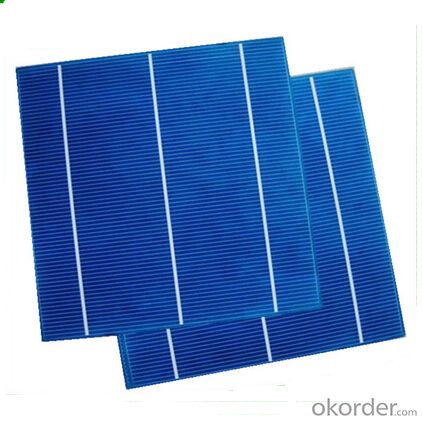
FAQ
We have organized several common questions for our clients,may help you sincerely:
1. What’s price per watt?
A: It’s depends on the quantity, delivery date and payment terms of the order. We can talk further about the detail price issue. Our products is high quality with lower price level.
2. Can you tell me the parameter of your solar cells?
We have different series of cells with different power output, both from c-si to a-si. Please take our specification sheet for your reference.
3. How do you pack your products?
We have rich experience on how to pack the panels to make sure the safety on shipment when it arrives at the destination.
4. Can you do OEM for us?
Yes, we can.
5. How long can we receive the product after purchase?
In the purchase of product within three working days, We will arrange the factory delivery as soon as possible. The perfect time of receiving is related to the state and position of customers. Commonly 7 to 10 working days can be served.
- Q: What is the role of combiners in solar cell systems?
- The role of combiners in solar cell systems is to combine the electrical outputs from multiple solar panels into a single output, increasing the overall power output of the system.
- Q: Can solar cells be used in mobile devices?
- Yes, solar cells can be used in mobile devices. In fact, many modern smartphones and tablets are equipped with solar panels or have the capability to be charged using solar energy. This allows for increased energy efficiency and convenience, especially when used in outdoor or remote locations.
- Q: How long does it take to install solar cells on a residential property?
- The installation of solar cells on a residential property typically takes a few days to a few weeks, depending on various factors such as the size of the system, the complexity of the installation, and the availability of the installation team.
- Q: What is the accurate explanation for the sun solar cell power system? How does it work?
- Even though the sun solar cell power system is much more developed then before, its working process is still a bit complicated compared to the conventional power supply system.
- Q: How do solar cells perform in coastal areas?
- Solar cells perform well in coastal areas due to the abundance of sunlight and the absence of obstructions that could potentially shade the panels. Additionally, the coastal breeze helps to keep the solar panels cool, preventing overheating and improving their overall efficiency.
- Q: How do solar cells perform in areas with high levels of pollen?
- Solar cells can be affected by high levels of pollen as it can accumulate on the surface of the cells and reduce their efficiency. The pollen can block sunlight from reaching the cells and hinder their ability to generate electricity. Regular cleaning and maintenance of solar panels in areas with high pollen levels are crucial to ensure optimal performance.
- Q: What is the impact of solar cell installations on job creation?
- The impact of solar cell installations on job creation is significant. As the demand for renewable energy continues to grow, the solar industry has experienced substantial job growth. Installing solar cells requires a skilled workforce, creating employment opportunities in manufacturing, installation, maintenance, and sales. Moreover, the development of solar projects stimulates local economies, attracting investments and creating jobs in related sectors such as engineering, finance, and construction. Therefore, solar cell installations have a positive impact on job creation, fostering a sustainable and thriving green economy.
- Q: How to get high voltage, high current output of solar cells
- Series can increase the output voltage, parallel can provide output current. Using a series parallel method to achieve, for example: need 220 volts 10 amps.
- Q: Can solar cells be used for powering wildlife tracking devices?
- Yes, solar cells can be used for powering wildlife tracking devices. Solar cells convert sunlight into electrical energy, which can be stored in batteries and used to power various devices, including wildlife tracking devices. This allows for continuous and sustainable power supply, eliminating the need for frequent battery replacements or recharging.
- Q: What is the effect of wind on solar cell performance?
- The effect of wind on solar cell performance can be both positive and negative. On one hand, a gentle breeze can help cool the solar panels, preventing them from overheating and improving their efficiency. On the other hand, strong winds can cause vibrations and movement in the panels, leading to potential damage or misalignment. Therefore, while some wind can be beneficial, excessive or turbulent winds can have a detrimental impact on solar cell performance.
Send your message to us
Indoor Polycrystalline Solar Cells Series - C-16.80%
- Loading Port:
- Shanghai
- Payment Terms:
- TT OR LC
- Min Order Qty:
- 3000 pc
- Supply Capability:
- 300000 pc/month
OKorder Service Pledge
OKorder Financial Service
Similar products
Hot products
Hot Searches
Related keywords
